

Virtual Pollution (Lecture 27) Children's Internet Protection Act. The Children's Internet Protection Act (CIPA) was enacted by Congress in 2000 to address concerns about children's access to obscene or harmful content over the Internet.
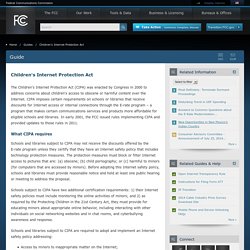
CIPA imposes certain requirements on schools or libraries that receive discounts for Internet access or internal connections through the E-rate program – a program that makes certain communications services and products more affordable for eligible schools and libraries. In early 2001, the FCC issued rules implementing CIPA and provided updates to those rules in 2011. What CIPA requires Schools and libraries subject to CIPA may not receive the discounts offered by the E-rate program unless they certify that they have an Internet safety policy that includes technology protection measures. The protection measures must block or filter Internet access to pictures that are: (a) obscene; (b) child pornography; or (c) harmful to minors (for computers that are accessed by minors). Filing a complaint Accessible formats Print Out.
The Franklin Prophecy. "The Franklin Prophecy", sometimes called "The Franklin Forgery", is an antisemitic speech falsely attributed to Benjamin Franklin, warning of the supposed dangers of admitting Jews to the nascent United States.
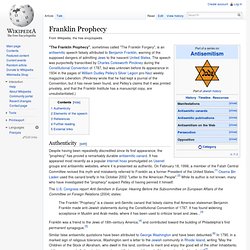
The speech was purportedly transcribed by Charles Cotesworth Pinckney during the Constitutional Convention of 1787, but was unknown before its appearance in 1934 in the pages of William Dudley Pelley's Silver Legion pro-Nazi weekly magazine Liberation. (Pinckney wrote that he had kept a journal of the Convention, but it has never been found, and Pelley's claims that it was printed privately, and that the Franklin Institute has a manuscript copy, are unsubstantiated.) Authenticity[edit] Despite having been repeatedly discredited since its first appearance, the "prophecy" has proved a remarkably durable antisemitic canard. It has appeared most recently as a popular internet hoax promulgated on Usenet groups and antisemitic websites, where it is presented as authentic. Anti-Semitic Myth: The Franklin "Prophecy" - Part 1. Introduction.

The Underground Web. It's the kind of call everyone dreads.

For Kristen Bonnett, the daughter of NASCAR race driver Neil Bonnett, it came on Feb. 11, 1994--the day her father crashed during a practice run at the Daytona International Speedway. A few hours later, he died. Bonnett was devastated, but she got on with her life. Then, seven years later, came a second call. Social Implications (Lecture 26)
Paradox of knowledge-Can knowledge be sticky,leaky and intangible-its contradictory qualities. From Counterculture to Cyberculture: Stewart Brand, the Whole Earth Network, and the Rise of Digital Utopianism, Turner. Turner2.pdf (application/pdf Object) The University is Dead. The University is Dead!
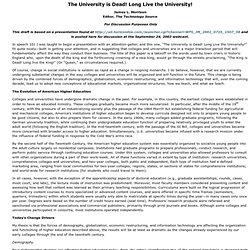
Long Live the University! James L. MorrisonEditor, The Technology Source For Discussion Purposes Only This draft is based on a presentation found at and is posted here for discussion at the September 24, 2002 webcast. In speech 101 I was taught to begin a presentation with an attention-getter, and this one, "The University is Dead! Of course, change in social institutions is seldom as rapid as a change in reigning monarchs. Behold the Computer Revolution. Chief of confusion. In contrast to bombs, viruses, whether bioengineered or software engineered, pose insidious and invisible threats.
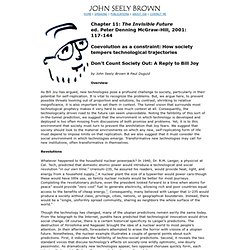
And whereas only states had the infrastructure and finances to develop the former, the latter may need only cheap, readily available devices to instigate irreversible threats to all humanity. Able to take advantage of our dense, social and technological interconnections to replicate, these threats will spread from obscure beginnings to devastating ends-as the “I love you” virus spread from student’s computer in Manila to cripple computers around the world. It may nonetheless be something of a disarming overstatement to suggest that these positions are unprecedented. Different forms of biological warfare, have been with us for a long time and can teach us something about future threats. Negatrends.pdf (application/pdf Object) Alfred Marshall. Life and Career[edit] Marshall was born in Clapham, England, July 26, 1842.

His father was a bank cashier and a devout Evangelical. Marshall grew up in the London suburb of Clapham and was educated at the Merchant Taylors' School and St John's College, Cambridge, where he demonstrated an aptitude in mathematics, achieving the rank of Second Wrangler in the 1865 Cambridge Mathematical Tripos.[1][2] Marshall experienced a mental crisis that led him to abandon physics and switch to philosophy. He began with metaphysics, specifically "the philosophical foundation of knowledge, especially in relation to theology.
".[3] Metaphysics led Marshall to ethics, specifically a Sidgwickian version of utilitarianism; ethics, in turn, led him to economics, because economics played an essential role in providing the preconditions for the improvement of the working class. The Death of Distance. Revisiting the death of distance. Since Cairncross (1997), the notion of the “death of distance” has gained traction, both in the work of academics but more especially in the popular image of globalisation.

Citing radical improvements in the cost and efficacy of long-distance communication and transportation, Cairncross depicts a world marked by the free movement of goods, people, and ideas. Unfortunately, this prognosis has been difficult to identify in present-day trade data. One of the first studies to recognise this was Leamer and Levinsohn (1995), who write “that the effect of distance on trade patterns is not diminishing over time.
Contrary to popular impression, the world is not getting dramatically smaller”. Taking this view as a starting point, a string of papers has strongly confirmed their initial results. Social Impact of the Internet (Lecture 25) A Rape in Cyberspace. "A Rape in Cyberspace, or How an Evil Clown, a Haitian Trickster Spirit, Two Wizards, and a Cast of Dozens Turned a Database into a Society" is an article written by freelance journalist Julian Dibbell and first published in The Village Voice in 1993.
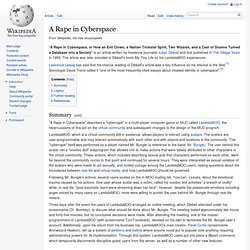
The article was later included in Dibbell's book My Tiny Life on his LambdaMOO experiences. Lawrence Lessig has said that his chance reading of Dibbell's article was a key influence on his interest in the field.[1] Sociologist David Trend called it "one of the most frequently cited essays about cloaked identity in cyberspace".[2] Summary[edit] Social Implications of the Internet - Annual Review of Sociology, 27(1):307. The WELL. The Whole Earth 'Lectronic Link, normally shortened to The WELL, is one of the oldest virtual communities in continuous operation.

As of June 2012, it had 2,693 members.[2] It is best known for its Internet forums, but also provides email, shell accounts, and web pages. The discussion and topics on the WELL range from deeply serious to trivial, depending on the nature and interests of the participants. History[edit] In August 2005 Salon Media Group announced that it was looking for a buyer for the WELL, in order to concentrate on other business lines. Will the Internet Always Speak English? In 1898, when Otto von Bismarck was an old man, a journalist asked him what he took to be the decisive factor in modern history. He answered, "The fact that the North Americans speak English. " In retrospect, he was spot on the mark about the political and economic developments of the twentieth century, and up to now he seems to have been prescient about the development of the technologies that will shape the next one.
The Internet was basically an American development, and it naturally spread most rapidly among the other countries of the English-speaking world. Right now, for example, there are roughly as many Internet users in Australia as in either France or Italy, and the English-speaking world as a whole accounts for over 80 percent of top-level Internet hosts and generates close to 80 percent of Internet traffic. It isn't surprising, then, that the Web is dominated by English. The Polarization of Extremes - The Chronicle Review. WhiteFlightDraft3.pdf (application/pdf Object) Disintermediation... (Lecture 24) The disaggregation of news. Traditionally news were always presented in neatly edited packaged. No more. In web 2.0 the individual news story frequently becomes more important than the edited package. What does this mean for news providers? Newspapers, radio and television have a set of common limitations of how news are presented to the public: All are mainly one-way channels: Editors choose which stories are important and broadcast them to the public.
Journalists are trained within the same tradition: You look at the world, choose which stories are important and present them in a package within predefined physical limits. Extra, Extra: Is It the End for Newspapers? The headlines are grim. Financial trouble is pushing newspapers, which have been an American staple in small towns and major cities for more than 400 years, to the brink. From the Rocky Mountain News in Denver, Colo., which published its last edition today, to the San Francisco Chronicle, which is in danger of stopping the presses, trouble is brewing. Watch "World News with Charles Gibson" TONIGHT at 6:30 p.m. E.T. for the full report. The 144-year-old, Hearst-owned San Francisco paper has survived fire and earthquakes but may not survive in the current economic climate.
"I don't think I'm safe, and I don't think anyone in that newsroom feels that they're safe," said C.W. Even the American Society of Newspaper Editors today announced it has canceled its 2009 convention, a first since World War II, concluding that "the challenges editors face at their newspapers demand their full attention. " Daily newspapers have been the public's eyes and ears, exposing corruption and scams. Material Matters. 1 Good bye the book? With barely the flick of a digital switch, the long era of the "coming of the book" appears to have given way to the brief period of its going.[1] For it is going, predictions insist, like the telegram, the Bakelite phone, the vinyl record, or the analog computer before it. United only in a shared sense of inevitability, gloomy bibliophiles and triumphant technophiles wave the book good bye.[2] As elegies are read, eyes turn from history to the future.
To be concerned with the past risks appearing like Shakespeare's Salisbury, vainly trying to "call back yesterday, bid time return", while to talk about the continued relevance of the book can pick you out as a modern Erewhonian.[3] The Future of Books. 2020: All Books Will Be Cross-Platform and Interactive. Future “books” will be bundled with soundtracks, musical leitmotifs, 3-D graphics, and streaming video. They’ll be enhanced with social bookmarking, online dating, and alerts from geo-networking apps whenever someone in your locality purchases the same book as you— anything so you don’t have to actually read the thing.
Authors will do their own marketing, the reader will be responsible for distribution, the wisdom of crowds will take care of the editing, and the invisible hand of the market will perform the actual writing (if any). Writers will respond either by going viral or by going feral. 2030: All Books Will Be Crowdsourced and Cloud-Based.
Novelists will start out designing their characters in the form of sets of vinyl figurines. 2040: Authors Will Become Like Tamagotchi. 2050: Analog Reading Will Be Digitally Simulated. 2060: Physical Books Will Make a Comeback in Annoying Contexts. 2070: We Will All Become Cyborgs. Google & the Future of Books by Robert Darnton. How can we navigate through the information landscape that is only beginning to come into view? Umberto Eco Afterword. Orphan Works. 5 Ways to Monetize the Future of News Media. This series is supported by The Poynter Institute’s Mobile Media blog – your guide to the intersection of mobile and media.
Sign up to receive the blog in newsletter format and be entered into a drawing to win an iPad at Poynter.org/ipadgiveaway. News media — including newspapers, news weeklies and TV news programs — was struggling long before the 2008 financial crisis and subsequent recession. It was a struggle, however, that many investors in 2006 and 2007 perceived as merely a temporary setback — a setback they attempted to capitalize on by snatching up seemingly undervalued media companies. In 2006, newspaper publisher McClatchy acquired what was then the second largest newspaper publisher in the U.S., Knight Ridder, for $4.5 billion in cash and also financed $2 billion of the company's debt. The recession has forced news organizations to face what they have long suspected: Their business models are broken. The numbers are ugly. 1. 2. The WSJ's current model is not perfect, however. The iPad, the Kindle, and the future of books.